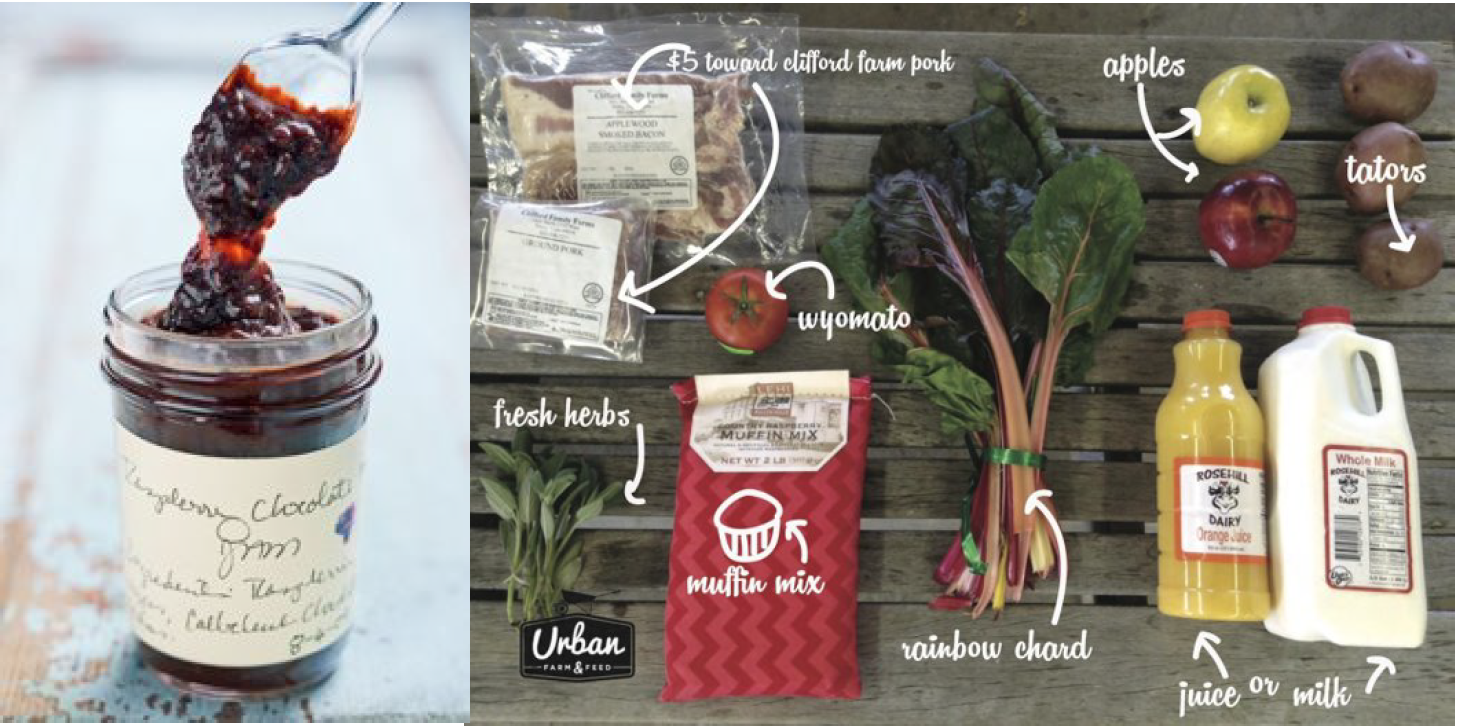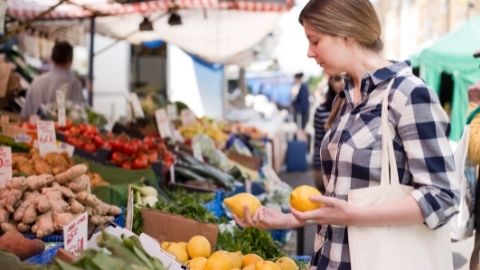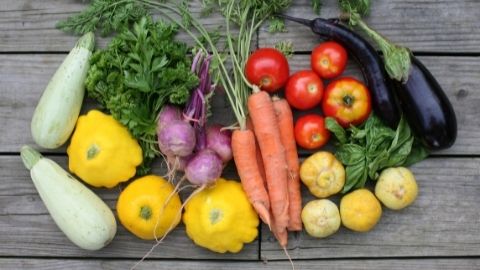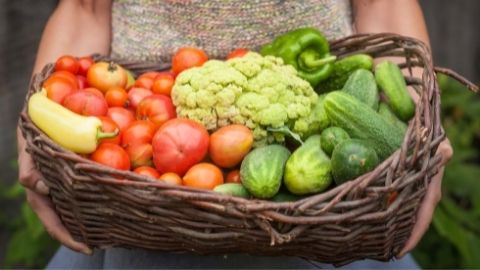Farm Shops: A Direct-to-Consumer Extended Season Opportunity
Introduction
Throughout the past two decades, consumer demand for locally produced food has rapidly increased. This is partially due to the growing importance of food tourism, as well as the expansion of the “Buy Local” movement. As a result, the opportunity for extended season sales for small growers and food producers has arisen. Farm shops provide growers the opportunity to fulfill consumer demand for local foods, as well as provide a year-long revenue stream and diversification strategy (Slocum and Curtis, 2017). A farm shop is a permanent or semi-permanent structure where farm products from a specific farm or multiple farms, both fresh and processed (such as jams, honey and cheese), are offered for direct sale to consumers. Shops are normally open to the public year-round and often provide snacks, a bakery or butchery, or a small café. Shops may be located on a farm or in nearby towns or cities, and they are frequently operated by the grower.
This fact sheet discusses the impact of the expanding food tourism and local food movements on the demand for locally-produced goods, how farms shops can cater to that demand, the advantages and disadvantages of farms shops for both growers and consumers, and best practice suggestions for operating farm shops.
Introduction
 Tourists and restaurant clientele are demanding local foods more than ever before. The desire to visit local-sourcing restaurants is evidenced by the National Restaurant Association's 2015 Restaurant Industry Forecast, which reported that 7 out of 10 consumers were more likely to visit a restaurant offering locally sourced items. Additionally, the “Top 5 2015 Menu Trends” included locally sourced meats/seafood and locally grown produce as the top two trends (National Restaurant Association, 2015). The food tourism industry is also growing rapidly. Tourists and travelers are interested in consuming food and drink that reflect local identity and culture. In fact, they consider the consumption of those items to be “vital” to their experience. It’s estimated that 35% of tourist expenditures are on food/drink, and food tourists consider price a less important factor than experiencing local culture (Hall and Sharples, 2003). Food tourism examples include farm stays, beer and wine festivals, winery visits, food festivals, brewery tours, dining at ethnic restaurants, etc.
Tourists and restaurant clientele are demanding local foods more than ever before. The desire to visit local-sourcing restaurants is evidenced by the National Restaurant Association's 2015 Restaurant Industry Forecast, which reported that 7 out of 10 consumers were more likely to visit a restaurant offering locally sourced items. Additionally, the “Top 5 2015 Menu Trends” included locally sourced meats/seafood and locally grown produce as the top two trends (National Restaurant Association, 2015). The food tourism industry is also growing rapidly. Tourists and travelers are interested in consuming food and drink that reflect local identity and culture. In fact, they consider the consumption of those items to be “vital” to their experience. It’s estimated that 35% of tourist expenditures are on food/drink, and food tourists consider price a less important factor than experiencing local culture (Hall and Sharples, 2003). Food tourism examples include farm stays, beer and wine festivals, winery visits, food festivals, brewery tours, dining at ethnic restaurants, etc.
The Intermountain West is an ideal tourism market, and thereby an ideal place for farm shops. This region contains more than 20 national and state parks and touts some of the best skiing in the world. Due to the year-round nature of the outdoor recreational opportunities, tourists come to this area throughout the winter and summer months. For example, in 2017, Utah had 19.3 million total visitors, including 4.2 million skier visits and 15.1 million national park service visits. Tourism is a key industry for Utah. In 2017, visitor spending alone totaled $9.15 billion USD (UOT, 2018). The tourist population creates a constant demand for fresh local produce and other regional food products. Farm shops can provide growers the opportunity to meet this demand. Through provision of local foods and value-added products, growers can deliver the culinary experience visitors desire year-round, while benefiting from the additional revenue stream.
Role of Food Tourism
Tourists and restaurant clientele are demanding local foods more than ever before. The desire to visit localsourcing restaurants is evidenced by the National Restaurant Association's 2015 Restaurant Industry Forecast, which reported that 7 out of 10 consumers. The Intermountain West is an ideal tourism market, and thereby an ideal place for farm shops. This region contains more than 20 national and state parks and touts some of the best skiing in the world. Due to the year-round nature of the outdoor recreational opportunities, tourists come to this area throughout the winter and summer months. For example, in 2017, Utah had 19.3 million total visitors, including 4.2 million skier visits and 15.1 million national park service visits. Tourism is a key industry for Utah. In 2017, visitor spending alone totaled $9.15 billion USD (UOT, 2018). The tourist population creates a constant demand for fresh local produce and other regional food products. Farm shops can provide growers the opportunity to meet this demand. Through provision of local foods and value-added products, growers can deliver the culinary experience visitors desire year-round, while benefiting from the additional revenue stream.
Benefits of Season Extension
As the demand for fresh produce and locally-produced food increases, farmers’ markets are becoming progressively more common. From 2000-2017, the number of farmers’ markets increased nation-wide by over 200% (USDA-AMS, 2017). Also, there was a 275% increase in community supported agriculture (CSA) programs from 2004 to 2014, and a 288% increase in the regional food hubs from 2007 to 2014 (Low et al., 2015). One of the primary benefits of farm shops is their ability to extend the season for small growers that usually rely on profits from a 5-month (or less) season. The shops can extend the sales season beyond 7 months, greatly enhancing revenues, and providing a solution to the annual demand for fresh, locally-produced foods. Extending the sales season provides an additional $448 of revenue per week for the average farmers’ market farmer, meaning an additional $2,681 per month per additional outlet, or a threefold increase in revenue (Brown et al., 2007). In order to extend the sales season, farm shop owners must diversify into value-added processed products. This involves using the summer extras, or culls, for processing, and selling those products at a premium in the winter months. Value-added products include, for example, honey, cheese, vinegar, salsa, jams, jellies, jerky, etc. Farm shops can also offer fresh produce produced in hoop houses during the off-season, as well as frozen foods, specialty meats and cheeses, and ready to eat foods. An in-house café, restaurant, bakery, or butcher shop, or the addition of an event venue or petting zoo are other services provided at farm shops and provide a valuable source of off-season revenue.
Farm Shop Best Practices
The overarching goal of a farm shop is to provide an outlet for current products, while reducing transportation costs and increasing year-round sales. Farm shops provide an outlet for value-added products, as well as a more consistent source of income and employment for growers. The advantages and disadvantages of farm shops for both growers and consumers are described below.
Advantages and disadvantages of farm shops for the grower/owner
A major advantage of owning a farm shop is its ability to highlight local agriculture and create a fun, interesting location where consumers can browse and find local food items. It allows growers to sell specialty items and interact personally with customers, resulting in immediate feedback and repeat sales. Farm shops also reduce the transportation costs associated with other direct sales outlets and allow growers to benefit from additional year-round sales. By selling locally-grown and produced products, growers can foster relationships within the community. These relationships attract customers and provide positive publicity. It also connects growers with local networks, increasing grower understanding of consumer preferences, allowing for the adjustment of offerings to better suit clientele and increase revenue.
The primary difficulty that arises with farm shops is the seasonal nature of local produce production. As a result, during the winter months sales are reliant upon value-added products. Producing goods in the off season can result in premium pricing, thus widening the price gap between locally grown and grocery store products. Also, shops are more appealing to consumers when a variety of products are available. This requires either a more varied production plan or partnering with other growers and food producers. This cooperation can be difficult, but by communicating with and supporting other local growers, it can be achieved.
Advantages of farm shops for the consumer
Farm shops appeal to consumer perceptions that locally-grown produce is fresh, tastes better, and is healthier (Curtis and Cowee, 2011). Consumers also tend to feel that local foods are better for the environment due to the reduced transportation needs and decreased emissions resulting in a lower carbon footprint overall. Also, many want to support their local economy, including local growers (Curtis and Cowee, 2011). When they buy local, consumers recognize the business positively supports the community as a whole. While prices might be higher, the benefits associated with local products provide the consumer with additional value. Farm shop visitors also desire the opportunity to meet local growers as they get to know the region better and participate in the local economy.
Suggestions for operating a farm shop
- Select a good location – The best location for a farm shop is one close to a busy road or intersection. Select a site near corners, street lights or other small businesses like bakeries. Easy access with plenty of parking space is important, and a building with lots of open space or an open-air section is ideal and helpful. The shop must be visible and easy to identify, but any signage should be in accordance with county or city regulations.
- Source products carefully – When possible, the grower should sell their own produce or products. Products provided by others may be priced high, resulting in lower profits. If outside products need to be sourced, use local sources whenever possible. Local suppliers respond more rapidly and innovatively than their conventional counterparts, especially in situations where there is sudden high demand or other unforeseen circumstances. Also, delivery times are more predictable, and the probability of product recalls is significantly lower. As customer demand for diverse and environmentally-friendly (spray-free, organic, raw/unprocessed, grass-fed, pasture-raised, non-GMO) produce continues to grow, it is important to label products with these traits. Provide a variety of products to customers, focusing on value-added products such as cheese, jam, jelly, honey, juice, salsa, etc. This broadens product offerings to foods that are ready to eat, and convenience is key! Be aware, however, of codes and regulations regarding these products. Overall, remember that product quality is crucial. Frequent product testing, farm visits and safety inspections will not only result in high-quality products but will earn customer trust.
- Become educated and connected – When building a farm shop business, start small and build up over time. Education is key. Attend conferences, Extension programs, DOA workshops, etc. Visit farmers’ markets, farms, talk with growers and invite them to visit. Sourcing items from farmers’ markets is a good way to establish relationships with local food artisans, highlight local products and learn more about local preferences. Building relationships with local providers allow farm shop owners to provide input on what products or varieties should be grown or processed in the future. It will also help customers recognize the business as a supporter of the community and local economy. People want to be educated about the food they eat and will have more respect and trust for businesses that are transparent about where their products come from. Allow consumers and farmers to connect with one another. Use websites, social media, and face-to-face meetings to help customers reach out to farmers when they have questions or comments. Don’t be afraid to promote! Let your customers know what’s going on and why it’s important.
- Diversify – Find ways to diversify and set the farm shop apart from other offerings in the community. Selling produce with interesting names and colors is a great way to start. Consider adding a restaurant, café, bakery, or butcher’s shop to expand the array of available goods and services. Those elements provide additional incentive for customers and add an element of uniqueness to the farm shop. Be a pick-up-point for CSA baskets. This will attract customers to the shop while showing them where they can get additional local foods. Join local labeling programs such as Utah’s Own. This allows the community to recognize the shop as part of the local economy. Work with local chamber of commerce and visitors’ bureaus to expand the shops promotional opportunities. Conduct tasting events, dinners, and tours as opportunities for the community to sample products and start a club rewards program to encourage repeat business and gather customer feedback.
Conclusions
This fact sheet provides information about the market opportunity farm shops provide for local growers. The opportunity is a result of increased consumer demand for locally-produced foods, largely driven by growth in the food tourism industry and the “Buy Local” movement. The opportunities for tourism in the Intermountain West make it an ideal region for farm shops to serve visitors and local residents. Farm shops are advantageous for both growers and consumers. For growers, farm shops extend the sales season, leading to increased annual revenues and the potential to reduce costs, such as transportation. For consumers, farm shops provide desired local food experiences for tourists and access to the local, healthy, and fresh foods local residents seek. Best practices for farm shop development and operation are also provided, including the importance of location, sourcing from local providers, ensuring high quality products, and community involvement and networking.
References
- Brown, C., S. Gartin, T. McConnell, H. Boone, S. Miller, and D. Boone. 2007. The Importance of Farmers' Markets for West Virginia Direct Marketers. Renewable Agriculture and Food Systems 22(1):20-29.
- Curtis, K.R., and M.W. Cowee. 2011. Buying Local: Diverging Consumer Motivations and Concerns. Journal of Agribusiness 29(1):1-22.
- Hall, C.M., and L. Sharples, L. 2003. The Consumption of Experiences or the Experiences of Consumption? An Introduction to the Tourism of Taste. Hall, C., L. Sharples, R. Mitchell, N. Macionis, and B. Cambourne (Eds.). Food Tourism: Around the World: Development, Management and Markets. Chapter 1, p.1-24, Butterworth-Heinemann, Oxford.
- Low, S., A. Adalja, E. Beaulieu, N. Key, S. Martinez, A. Melton, … and B. Jablonski. 2015. Trends in U.S. local and regional food systems: A report to Congress. (U.S. Department of Agriculture, Economic Research Service Administrative Publication AP-068). Retrieved from http://www.ers.usda.gov/publications/ap-administrative-publication/ap-068.aspx.
- National Restaurant Association. (2015). Restaurant industry forecast. Retrieved from http://www.restaurant.org/News-Research/Research/Forecast-2015.
- Slocum, S., and K. Curtis. 2017. Farm Diversification through Farm Shop Entrepreneurship in the UK. Journal of Food Distribution Research 48(2):35-51.
- U.S. Department of Agriculture, Agricultural Marketing Service (USDA-AMS). 2017. Farmers Market and Direct-to-Consumer Marketing. Retrieved from https://www.ams.usda.gov/services/local-regional/farmers-markets-and-direct-consumer-marketing.
- Utah Office of Tourism (UOT). 2018. Utah tourism industry metrics. Retrieved from https://travel.utah.gov/research-planning/utah-tourism-industry-metrics.

This material is based upon work supported by USDA/NIFA under Award Number 2015-49200-24225.
Date Published: May 2019
Authors
Kynda R. Curtis, Professor and Extension Specialist, Department of Applied Economics; Emily Rice, Undergraduate Extension Intern, Department of Applied Economics; Susan L. Slocum, Associate Professor, Tourism and Event Management, George Mason University; Karin Allen, Associate Professor and Extension Specialist, Department of Nutrition, Dietetics, and Food Science
Related Research









